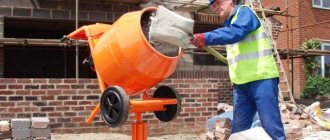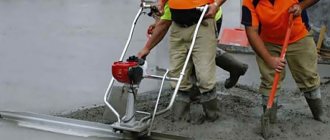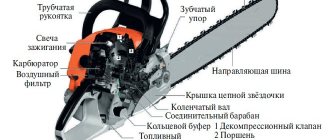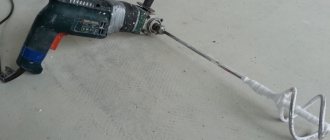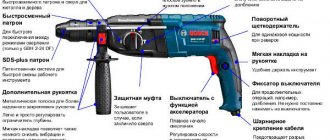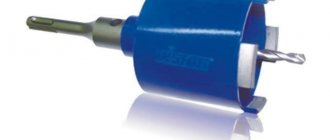X
Those who have their own dachas or private houses know how important concrete mortar is for any construction work, and it is especially important to know how to calculate the proportions of concrete in buckets. This is the basis of everything. Many people order mortar from construction organizations, and then struggle with the question of “when will it be delivered?” and “what quality will the mixture be?” Luckily, we'll tell you how to make high-quality concrete for your foundation yourself!
For small areas, it is better to measure the volume of components manually in buckets. By acting this way, you will spend less time on the process itself, and the solution will be of higher quality. How many buckets of components are needed to make concrete is calculated depending on the amount of work. All components for concrete composition have different amounts of capacity per bucket:
- cement 15 kg;
- sand 19 kg;
- crushed stone 17.5 kg.
Prepare a deep trough of mortar and use shovels to mix by hand.
Helpful information:
- Proportions of concrete for the foundation
- Concrete proportions: how to mix correctly
- How to choose impregnation for concrete
- Proportions of concrete for the blind area around the house
- Screw piles: pros and cons of the foundation
- Vibrator for concrete
“How much sand do you need for a bucket of cement?” - the most asked question of all beginners. Now let's look at everything in order.
The concrete recipe is used in almost all areas of construction: on foundations, wall ceilings, and when cladding both internal and external surfaces of buildings.
It is advisable to make concrete mortar using buckets in the following cases:
- No large-scale construction work is planned.
- Filling the desired area is done in stages.
- It is impossible to transport special equipment to the work site.
- A large distance from objects that can provide ready-mixed concrete.
Proportions of components per 1m3 of concrete, using buckets:
- 2 buckets of cement;
- 5 buckets of sand;
- 9 buckets of crushed stone.
Having prepared the necessary components, we begin mixing the concrete. The ratio of water and cement is 1 to 2, that is, water will require 50 percent of the amount of cement. It is better to pour it at the end, after adding all the ingredients.
It is recommended to produce the solution before starting work and in the amount that you plan to use within 2 hours.
The most popular brands of concrete and their purposes
- Concrete grade M100 is used in the initial stages of working with the foundation.
- M150 is a little stronger, it is used to fill screeds.
- M200 is the most common for pouring foundations and constructing reinforced concrete products.
- M250 - for creating small floor slabs and sports. platforms.
- M350 - recommended for the foundation of large-scale buildings.
- M450 - applicable for the construction of dams, dams, subways, etc.
Concrete substitute and its advantages
Concrete designations and areas of application
In order to divide concrete into types, alphanumeric designations are used. The first letter is “M”, followed by a number indicating the degree of concrete’s resistance to compression at the time of complete hardening (approximately a month). For example, M400, in this case the resistance is 400 kg/ms2. This means that the larger the digital designation, the more durable the concrete is.
For each type of construction work, a specific grade of concrete is used:
- grades from M100 to M150 are used for pouring under the foundation;
- M200 is the most common option; foundations, floor screeds, retaining walls and roads are poured with this brand;
- M350 is used as a fill for foundations for large structures, as well as for road decks.
- grades with higher performance are already used in the construction of more complex and heavy structures, such as various hydraulic structures, dams and dikes; they are not used in everyday life.
Proportions of components for the foundation
Even the most experienced builders and concrete workers will not be able to solve the problem: “What volume of components should be taken to make the most durable mortar?” As for concrete production, everything is approximate. The most significant factors that influence the quantity are humidity and fraction size.
Know the recommended ratios when using buckets and stick to them.
Proportion table for M400 concrete, sand and gravel:
Proportion table for M500 cement, sand and gravel:
Proportions of components for preparing 1 cubic meter. concrete
Foundation concrete has several grades, which are determined by the type of future structure, its weight and purpose. To prepare each brand of concrete, a specific brand of cement can be used. In general, these two factors determine the number of components required to prepare one cubic meter of concrete.
In most cases, concrete grade M 200 is used for the construction of foundations; it has sufficient strength and can withstand freezing and thawing many times. To make such a solution, M500 grade cement, medium-fraction crushed stone and water from the water supply are used.
To prepare one cubic meter of M200 concrete, you need to take the following number of components:
- Cement – 300-350 kg.
- Crushed stone – 1100-1200 kg.
- Sand – 600-700 kg.
- Water – 150-180 l.
To convert the indicated values into volume in buckets for more convenient measurement, it is enough to know the approximate mass of each component in one bucket. For example, a 10 liter bucket holds 15.6 kg of cement, 19.5 kg of sand and 17 kg of fine crushed stone. Therefore, to mix a concrete mass with a volume of 1 m3 you will need approximately 20 buckets of cement, 30 buckets of sand, about 70 buckets of crushed stone and 15-20 buckets of water. As you can see, calculating the proportions of concrete for the foundation in buckets is not so difficult.
We calculate the proportions of the required brand of concrete
The volume of cement is always counted as 100 percent. The remaining components are measured relative to it. It is usually customary to take volumes based on calculations for a 10-liter bucket. We remember that all materials have a unique weight characteristic. Eg:
- a bucket of cement has a mass of about 12.5 kg;
- 15 kg of sand is placed,
- crushed stone volume 17.5 kg.
The values are conditional, it all depends on the humidity and fraction.
Forced action concrete mixer and gravity unit
- All dry substances are mixed with water so that all sand and crushed stone is covered with liquid cement until a homogeneous mass is obtained. Practice has shown that mixing in a gravity concrete mixer increases the strength of concrete by up to 40%. Gravity units are compact, mobile, quickly disassembled for cleaning, and much cheaper;
- In a forced-action concrete mixer, mixing is carried out using blades in a stationary tank.
Forced concrete mixer
Nuances:
- The concrete mixer must stand on a level surface, leveling is carried out by placing blocks until the unit is brought into a stable horizontal state;
- When operating the equipment, it is prohibited to insert a shovel or hands into the tank or bend over it. For safety reasons, you need to wear gloves and goggles;
- To prevent the liquid mortar from sticking to the walls of the unit, before starting mixing, lubricate the walls of the concrete mixer with a liquid mixture of Portland cement, water and sand (or small crushed stone);
- First, half the volume of the prepared coarse aggregate is loaded into the tank and filled with water. Sand and Portland cement, as well as the rest of the aggregate, are added in small portions as mixing progresses;
- Sand, half of the crushed stone and Portland cement are first added to a small concrete mixer tank, mixed and water is added. After this, the remaining crushed stone is added;
- Mixing time for an inclined concrete mixer ≤ 2 min, for horizontal units – 1 min. If the time is increased, the water will evaporate and the solution will be less plastic;
- The mixture is checked for readiness as follows: the tank must be tilted and a little mixture poured into a bucket. Then, with a shovel, you need to make a series of notches on the mortar: a high-quality mortar will remain smooth and have a flat surface, the ridges from the shovel should not fall off - they should remain the same shape;
- Did the test show that the solution is not ready? Place it back into the concrete mixer and continue mixing;
- The finished solution is transferred or poured into buckets or a wheelbarrow.
After all operations, it is necessary to pour 5-7 liters of water into the concrete mixer and rinse it. The dirty water can be used for the next batch of concrete.
Mixing concrete in a concrete mixer: measure with buckets
Let's give an example. Let's say we need to mix M300 concrete:
- First, pour liquid into the concrete mixer. The mixer is dry, so the first time you knead, add additional water. A little liquid will be used to moisturize the construction machine. Fill in 8 liters of water.
- Further. Fill in 0.6 liters of plasticizer. A plasticizer is a special, intended admixture that allows you to make concrete more flexible by pouring a smaller volume of water. In addition, the plasticizer has the necessary properties of fluidity, plasticity, elasticity, and moisture absorption. Excess liquid in the solution during production has a negative effect on it, for this reason it is advisable to add liquid after completion if the mixture is thick.
- Next step. We fill in 4 buckets of crushed stone. As soon as the crushed stone gets wet, add 2 buckets of sand and 12.5 kilograms of M500 cement (about the size of a bucket)
Sand-gravel concrete (SGMC)
There are a huge number of options for how to prepare concrete at home and how to add all the components step by step. The example we just looked at is the most effective. In the case when cement and sand are first added to the water, and then crushed stone, the bulk sticks to the walls of the concrete mixer and after completion it is unrealistically difficult to clean it. Don't create a problem for yourself out of the blue.
By the way, prepare different buckets for liquid and sand so that the sand also does not stick.
- This whole mixture is mixed until smooth, which takes about 5 minutes.
- When the solution is ready, unload the mixture.
- Immediately pour water into the concrete mixer for the second batch of concrete without turning it off.
To mix concrete for the 2nd and subsequent times, pour in 7 liters of water. If you need more, add a little at a time.
Some also recommend pouring 5 liters. Although in reality, when you pour 7 liters, this is exactly what you need. If you pour less, the solution will be dry. Pour half a liter, see how it’s mixed, if it’s not enough, add more.
If you pour 1 liter or more at once, this may result in a liquid consistency. And this is already bad for the strength of concrete. Pour a little at a time.
The whole process is easy to implement. You can rent a concrete mixer or ask your old friends if they have one or know where to get a free home concrete mixer. For the component ratios we used in our example, you will need a 180 liter concrete mixer. As a result, approximately 60 liters of ready-made concrete solution was produced.
Accordingly, for a 120 liter concrete mixer, we would use smaller proportions and as a result we would get a smaller volume of concrete, approximately 40 liters of finished solution. This quantity is optimal for a concrete mixer. Rotates without overload, does not leak over the edges in an almost horizontal position, and mixes quickly.
After pouring the used mixture, compacting it, and leveling it, it must be given time to gain strength. This time interval is very important. Subsequently, it affects the protection against drying out and the fight against natural precipitation.
If the temperature is no more than 6 degrees, it is better to cover the fresh cement that has just been poured with a layer of polyethylene. In case of a hot sunny period, it is recommended to periodically moisturize for 6 - 8 days.
Proportions of concrete in buckets for a concrete mixer, recipe and work steps
The production of concrete by hand or machine involves different quantitative ratios of components.
To prepare concrete in a concrete mixer, use the classic recipe:
- cement – 2 parts;
- crushed stone - 8 parts;
- sand – 4 parts;
- water – 1 part.
Items for mixing concrete
Auxiliary components are added in the amount of 50 grams (1 glass).
The grade of cement affects the characteristics of the resulting composition, so when using cement grade M400, a concrete mixture of strength class B20, M500–B25 is obtained.
The ratio of classes and grades of concrete
Stages of work:
Mixing concrete
- Selection of composition.
- Preparatory work: sifting sand, washing and drying crushed stone.
- Turning on the concrete mixer.
- Loading materials in order of decreasing density: crushed stone, plastic composition (sand or gravel), cement.
- Stir the dry mixture for 10–20 minutes.
- Introduction of water with additives.
- Mix the solution for 2–3 minutes.
- Unloading concrete into a trough or working container with the drum tilted.
- Turning off the concrete mixer.
- Cleaning the drum with water and gravel, washing the blade.
Proportions for outdoor screed
The ratio of concrete for outdoor screed and its structure differs from the ratio and structure of the components for interior work. When the screed is in the open air, it experiences significant temperature changes, in addition to the negative effects of precipitation and wind.
How to make concrete flowerpots that the whole family will love
For this reason, you should use M150 and be sure to iron the top layer. Ratio of concrete screed used outdoors:
- 1 share of M400 cement, 4 shares of the purest river sand, 5.5 shares of crushed granite, 0.9 shares of water.
- 1 share of M500 cement, 4.1 shares of the purest river sand, 5.5 shares of granite crushed stone, 0.7 shares of water.
Manual preparation of concrete mixture
To prepare a high-quality concrete solution for the foundation, it is best to use a concrete mixer. However, this possibility is not always available. Sometimes purchasing or renting a concrete mixer is not possible due to a limited construction budget. There are situations when it is not possible to connect to the power supply. It is possible that using a concrete mixer is not rational due to the small amount of work. Problems of this kind can be solved by manually mixing the concrete mixture.
To work you will need the following:
- Two buckets: one bucket for cement, the other for other components and water.
- Two shovels, one of which is also used only for cement, the other works with sand and crushed stone.
- Wide container with high sides for easy mixing of ingredients.
The process of manual mixing of concrete mixture is as follows:
- Sand and crushed stone are poured into the container, mixed well and grooves are made on the surface.
- Cement is poured into the resulting recesses and the entire mixture is mixed until homogeneous.
- The mixture of dry ingredients is collected into a cone, at the top of which a hole is made.
- Pour a small amount of water into the recess of the cone and begin to mix. In this case, the kneading is carried out directly at the top of the cone so that the dry mixture is poured into the hole with water.
- When the poured water is absorbed, a cone is formed again with a depression in the upper part and more water is added. The steps are repeated until the required consistency of the concrete mass is obtained. It is very important not to pour all the water at once, as too much water can reduce the quality of the prepared solution.
Preparing concrete for the foundation is a very important stage, on which the strength and durability of the foundation and the entire structure depends. Therefore, it is very important to correctly select the components for mixing the concrete mass and calculate their proportions as accurately as possible.
When making a foundation, the most important thing is to use high-quality concrete of the required grade. Usually the mixture is purchased ready-made at a concrete plant, but this method is not always applicable, for example, due to the remoteness of the construction site, lack of access for heavy equipment, or a small amount of the required solution. This article calculates the proportions of components for the foundation in buckets for a concrete mixer when mixing it yourself.
The main characteristic of concrete is its grade. The strength properties of the composition depend on this indicator. It is designated by a number with the index M and varies from M50 to M1000. In private housing construction, the most commonly used mortar is M100-M400 grades.
- M100 is used for concrete preparation, fence foundations, light outbuildings
- M150 – the same as M100, plus light country houses, bathhouses
- M200 - the same as M150, plus small houses using frame technology, wooden, brick with light ceilings.
- M250-M350 are the main brands for private housing construction. Suitable for all types of residential buildings up to 3 floors high
- M400 - used in multi-storey residential construction. According to its technical characteristics, grade 400 concrete can be used in private housing construction, but this is not economically feasible.
Read also: Fireclay clay crucible
The grade of concrete is indicated in the design documentation. When designing independently, this indicator is chosen based on the expected load on the foundation.
To prepare a solution for pouring a foundation with your own hands, you will need the following materials:
To impart certain properties to the composition, special chemical or mineral additives are used - plasticizers, but they are used quite rarely. There are 2 brands of cement on sale: PC 400 and PC 500. Before preparing concrete, you need to calculate the required amount of binder and inert materials. This can be done using the following tables. The quantity is indicated in kilograms.
Table 1. Composition of concrete based on PC400 per m 3
| Brand, M | Cement PC 400, kg | Crushed stone, kg | Sand, kg | Water, l |
| 100 | 173 | 1150 | 757 | 190 |
| 150 | 214 | 1138 | 736 | 190 |
| 200 | 255 | 1127 | 714 | 190 |
| 250 | 296 | 1116 | 691 | 190 |
| 300 | 337 | 1105 | 669 | 190 |
| 350 | 378 | 1094 | 646 | 190 |
| 400 | 419 | 1083 | 623 | 190 |
Table 2. Composition of concrete based on PC500 per m 3
| Brand, M | Cement PC 500, kg | Crushed stone, kg | Sand, kg | Water, l |
| 100 | 158 | 1150 | 769 | 190 |
| 150 | 191 | 1138 | 754 | 190 |
| 200 | 224 | 1127 | 738 | 190 |
| 250 | 257 | 1116 | 722 | 190 |
| 300 | 291 | 1105 | 706 | 190 |
| 350 | 324 | 1094 | 690 | 190 |
| 400 | 357 | 1083 | 673 | 190 |
Using these tables, you can calculate the quantity of materials to order, but using them for dosing on a construction site is not very convenient, because you will have to weigh the components. Knowing the specific gravity and bulk density of materials, you can recalculate the table data by volume.
Bulk density, kg/m 3
- Cement m500 - 1300
- Crushed stone - 1400
- Sand - 1600
Table 3. Volume of components per m3 of concrete, binder – PC400
| Brand, M | Cement PC 400, l | Crushed stone, l | Sand, l | Water, l |
| 100 | 133 | 821 | 473 | 190 |
| 150 | 165 | 812 | 460 | 190 |
| 200 | 196 | 805 | 446 | 190 |
| 250 | 227 | 797 | 432 | 190 |
| 300 | 259 | 788 | 418 | 190 |
| 350 | 290 | 781 | 404 | 190 |
| 400 | 322 | 773 | 389 | 190 |
Table 4. Volume of components per m 3 of concrete, binder – PC500
| Brand, M | Cement PC 500, l | Crushed stone, l | Sand, l | Water, l |
| 100 | 122 | 821 | 480 | 190 |
| 150 | 147 | 812 | 471 | 190 |
| 200 | 172 | 805 | 461 | 190 |
| 250 | 198 | 797 | 451 | 190 |
| 300 | 224 | 788 | 441 | 190 |
| 350 | 249 | 781 | 431 | 190 |
| 400 | 275 | 773 | 420 | 190 |
To determine the number of buckets per 1 cubic meter of the finished mixture, you need to divide the table value by the volume of the bucket. For example: concrete M300, cement PC 500, bucket 12 l
- Cement 224/12=18.7
- Crushed stone 788/12=65.7
- Sand 441/12=36.8
When preparing the mixture in private construction, concrete mixers with a volume of much less than a cubic meter are used. To calculate the material needed for 1 batch, you need to divide the amount of material per 1 m3 by 1000 and multiply by the volume of the batch. This parameter is specified in the technical documentation of the tool. It is important not to confuse it with the volume of a concrete mixer.
Calculation example: concrete M300, cement PC500, bucket 12 l, batch volume 90 l
- Cement PC500 18.7/1000*90=1.683
- Crushed stone 65.7/1000*90=5.913
- Sand 36.8/1000*90=3.32
- Water 15.8/1000*90=1.425
The results obtained show the amount of raw materials in 12-liter buckets.
Also, to calculate materials, you can use the ratio binder: crushed stone: sand: water (C:B:P:W)
Table 6. Material ratio by volume. Volume of cement – 1.
| Concrete grade | Crushed stone | Sand | Water |
| PC 400 | |||
| 100 | 6,1 | 3,5 | 1,4 |
| 150 | 4,9 | 2,8 | 1,2 |
| 200 | 4,1 | 2,3 | 1 |
| 250 | 3,5 | 1,9 | 0,8 |
| 300 | 3 | 1,6 | 0,7 |
| 350 | 2,7 | 1,4 | 0,6 |
| 400 | 2,4 | 1,2 | 0,5 |
| PC 500 | |||
| 100 | 6,7 | 3,9 | 1,5 |
| 150 | 5,5 | 3,2 | 1,3 |
| 200 | 4,6 | 2,7 | 1,1 |
| 250 | 4 | 2,3 | 1 |
| 300 | 3,5 | 2 | 0,9 |
| 350 | 3,1 | 1,7 | 0,8 |
| 400 | 3 | 1,5 | 0,7 |
Example: concrete M300, PC500
Ratio C:SH:P:W 1:3.5:2:0.9
- Cement 1 bucket
- Crushed stone – 3.5
- Sand – 2
- Water – 0.9
Concrete should be mixed in gravity concrete mixers; forced-type mixers do not provide the required quality of the mixture and are not designed for large, heavy aggregates.
Proportions for fence posts
When producing concrete, in order to use it for a columnar fence foundation, it is necessary to adhere to certain ratios:
The proportions in the parts are as follows:
- Concrete M400 - 1 share.
- Gravel or crushed stone - 4 shares.
- Sifted sand - 2 shares.
- Water - 0.5 parts.
Calculation of proportions for the foundation is carried out in buckets.
Making a reliable mixture for the purpose of pouring a foundation for pillars is permissible subject to the following conditions:
- Be sure to use dry cement with a valid expiration date.
- It is recommended to use clean river sand.
- Homogeneous gravel composition.
How to make concrete. Proportions of concrete in buckets. Pouring the foundation
Proportions of concrete for the foundation
Foundation concrete is a combination of binder, filler, water and various additives.
The binder is almost always cement, which, depending on the load to withstand, can be of several grades: M200, M300, M400, M500 and M600.
Sand and crushed stone are used as filler. It is best to use river sand, and it should not contain clay impurities. The size of sand grains for high-quality concrete should not exceed 5 mm. It is better to take crushed stone for foundation concrete from crushed granite, as it is characterized by high strength. The fraction size should not exceed 2 cm.
Additives are necessary to give concrete the required characteristics. The mixture of dry ingredients is diluted with water to the desired consistency. Each component of concrete has its own function, so it is very important to choose the correct proportions of the components.
The water for preparing concrete must be clean, so it is recommended to take it from water supplies. If this is not possible, then it is allowed to use water from natural reservoirs, but with preliminary purification.
You can mix the concrete solution in a concrete mixer or manually using a certain amount of components. However, weighing materials is not always possible, so buckets are used for convenient measurement.
It is recommended to measure the volume of material with buckets when mixing a small amount of concrete. Many years of construction experience show that the correct batch should be made from components taken in the following ratio:
- Cement - 1 part.
- Sand - 3 parts.
- Crushed stone – 5 parts.
Preparing concrete by hand
In other words, for high-quality concrete, take 3 buckets of sand and 5 buckets of crushed stone for 1 bucket of cement. As for water, the calculated amount of this component is determined depending on the amount of cement; most often they take 0.5 parts of water to 1 part of cement. However, there are many factors that influence the amount of water to varying degrees. For example, using wet sand significantly reduces the water consumption to prepare a solution of the desired consistency. In addition, it is necessary to visually control the consistency of the concrete. The main thing is that it is thick and flexible, can hold its shape and not spread.
Concrete for the foundation in a concrete mixer: proportions of components and mixing technology
Concrete is an indispensable material for building the foundation of a house. Its strength and ability to withstand the required load directly depends on the preparation technology and compliance with the proportions of the components.
The exact proportions of concrete preparation depend on the brand of cement, material and size of the building for which the foundation is laid.
In construction, 4 types of concrete foundations are used, which have different characteristics and construction methods: strip, columnar, combined and slab.
